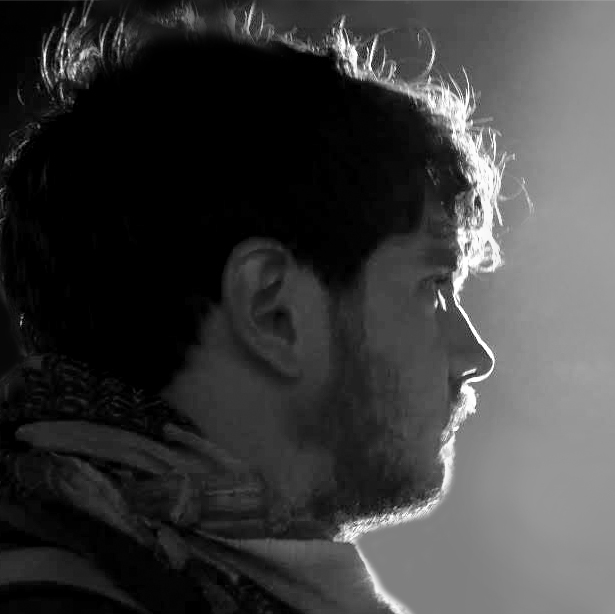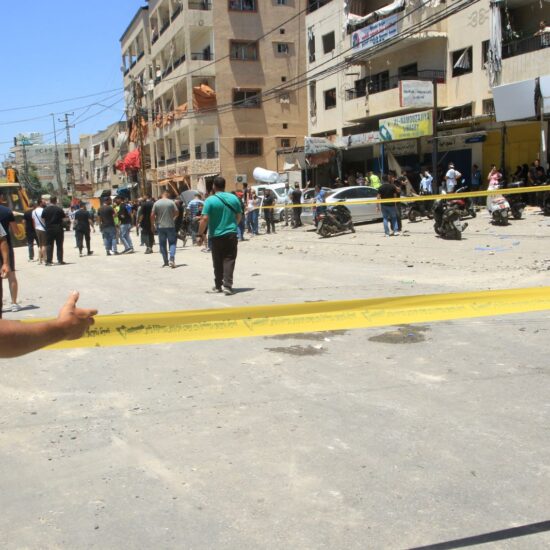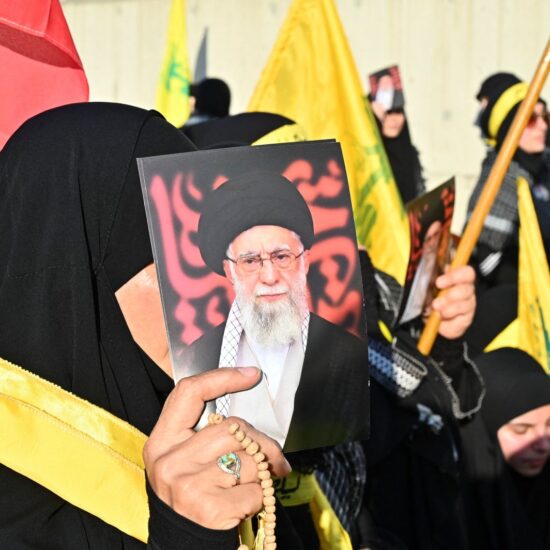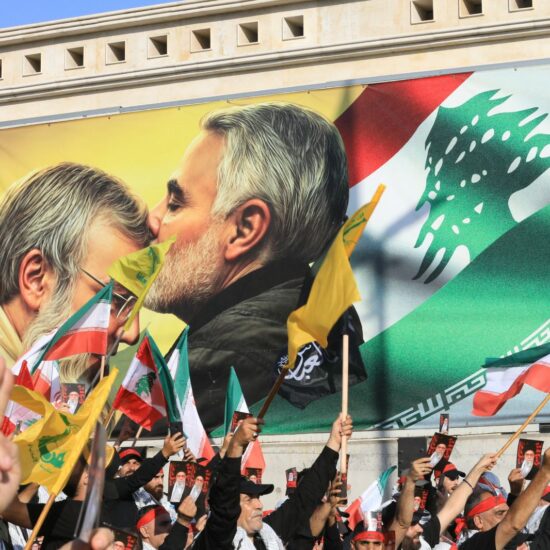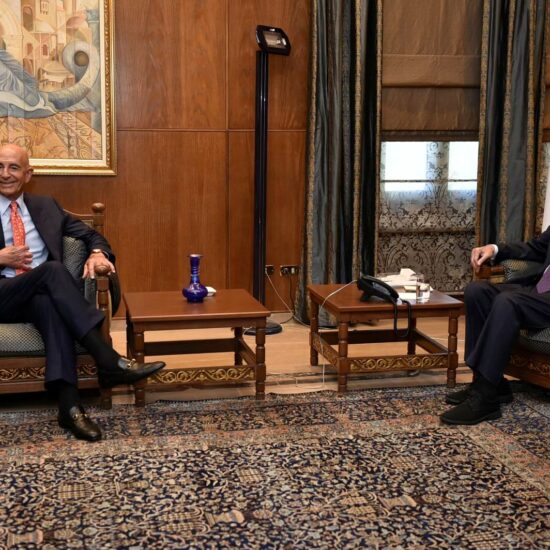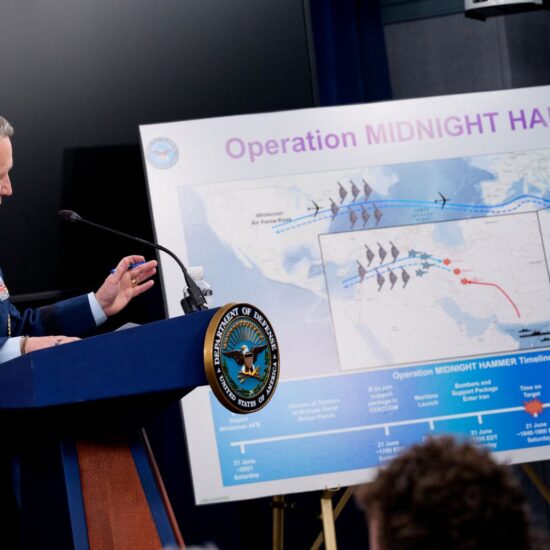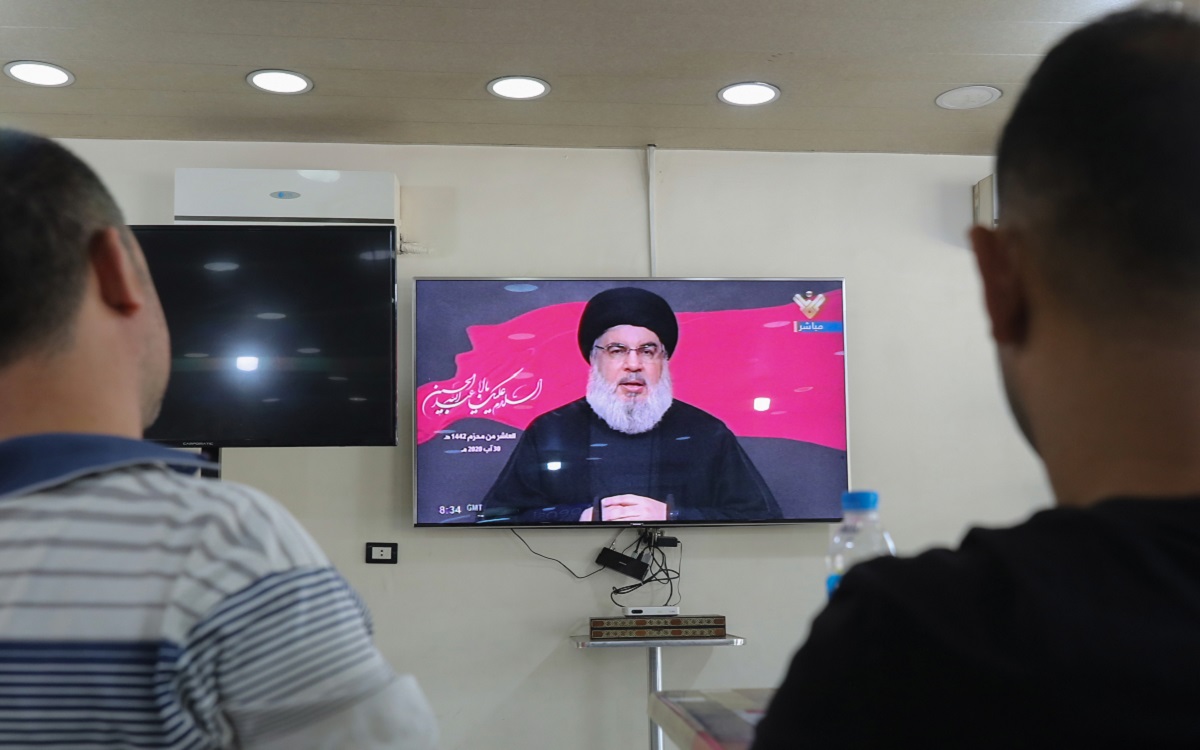
There was only a nondescript blue background and a collage of the people who died in the shootout on October 14 displayed behind Hezbollah leader Hassan Nasrallah when he spoke on Monday night on the occasion of the Prophet’s Birthday.
But the two-hour speech was not about the Prophet. It was about the Lebanese Forces Christian Party, whom the Party of God and its political ally the Amal Movement are accusing of having fired at their protesters and starting the clashes that left 7 dead and 32 wounded.
“The biggest threat for the Christian presence in Lebanon is the Lebanese Forces party and its head,” Hezbollah’s leader stated.
According to the Beirut-based Hezbollah analyst, Kassem Kassir, this speech by Nasrallah was meant as a deterrent for any possible fighting that could stem from the high tensions since Thursday’s events.
However, political analyst Bashar al-Halabi says that it was much more than that: Hezbollah is creating a new enemy for the group to confront.
However, he said, the move backfired, strengthening LF leader Samir Geagea’s political position and weakening that of the Hezbollahs’ Christian allies, President Michel Aoun and the Free Patriotic Movement.
“Of course, this means that it’s going to fuel sectarian tensions,” al-Halabi told NOW. “Of course, it means that it’s going to put its main Christian ally in a bind. Today, Michel Aoun and [Free Patriotic Movement leader] Gebran Bassil are really stuck between a rock and a hard place.”
An existential crisis
For the most part of its history, Hezbollah has conjured and strengthened enemies whether within Lebanon or outside of it in order to ensure the cohesion of its supporter base and to justify keeping its weapons, analysts say.
However, after the group declared victory over Sunni Islamists in the Syrian war, the Shiite group no longer had an immediate enemy to fight, Halabi explained.
“Since 2005 and up until last week, Hezbollah kind of obliterated March 14,” he said. “It went on and engaged in a war with Israel in 2006 and this was put to rest, in a way. Then it went to Syria and it helped quell the revolution and, then, it recreated itself as this militia that is trying to defend Shiites and other minorities.”
The party gained more power in Lebanon and became a super-political actor, defining Lebanon’s politics. It helped elect Michel Aoun into the presidential seat. Meanwhile, it continued to say that Israel was a threat that they would soon destroy. There were several rounds of unrest on the de facto border in South Lebanon, but all were extinguished within a few days. Hezbollah no longer had a physical enemy to pose as an imminent threat to its constituency.
The popular uprising began on October 17, 2019 and the beginning of the economic crisis only put more pressure on the group to change the narrative, as many accused it of being part of the corrupt Lebanese political elite.
“When Hezbollah came back from Syria, it literally had no enemy and it reached a point where it saw itself as the main guarantor and the main party responsible for the meltdown in Lebanon, in one way or the other,” Halabi stated.
“Its talking points around the banks and Riad Salameh did not stick enough. At the end of the day, Hezbollah and Hassan Nasrallah came out and publicly announced that the financial meltdown in Lebanon is a result of the American embargo. And all of the other talking points about Saad Hariri and meddling from abroad also did not stick.”
This all changed on October 14 when a shootout broke out in Tayouneh, an area that marks the border between the Christian Ain el-Remaneh and Shiite southern suburbs, between Hezbollah and Amal, the Lebanese Army and Lebanese Forces supporters.
When Hezbollah came back from Syria, it literally had no enemy and it reached a point where it saw itself as the main guarantor and the main party responsible for the meltdown in Lebanon, in one way or the other.
Hezbollah and Amal put out a joint statement after the shooting began, claiming that the Christian party ambushed them and were the cause of the fighting. The Lebanese Forces leader Samir Geagea denied that the party had planned any of the events on Thursday.
But a new opponent for Hezbollah had emerged.
Where the “100,000 strong” came from
In his speech, Nasrallah claimed that while the Lebanese Forces claim to be the protectors of Lebanese Christians, Hezbollah is the one that actually puts that into action, citing how there are Christians living in their territories and that Hezbollah was the one who defended them against threats like the Islamic State.
“Talking about defending Christians was to confirm that the problem with the [Lebanese] Forces is not with the Christians, but with a Lebanese party,” Kassir told NOW.
Nasrallah also continued the claims that the Lebanese Forces were the ones who killed Hezbollah members, accusing the Christian faction of trying to start a new civil war.
“The real program of the Lebanese Forces party is civil war,” Nasrallah said. “They don’t have a problem with causing events that lead to bloodshed … even if it will lead to a large-scale military confrontation of civil war.”
Nasrallah also said that his party had 100,000 fighters, a number significantly higher than the 85,000 that was previously thought.
“We have prepared [those fighters] with their diverse weapons to defend our territory, our oil and gas that is being robbed before the eyes of the Lebanese, to protect the dignity and sovereignty of our country from any aggression [and] terrorism and not for internal fighting,” Hezbollah’s leader stated.
“Don’t miscalculate. Be wise and behave. Learn a lesson from all your wars and all our wars,” Nasrallah later said addressing Geagea.
Hezbollah’s leader had reason to use such numbers in his speech. In 2020, the Hezbollah affiliated newspaper Al-Akhbar published a story claiming that the Lebanese Forces’ Samir Geagea had said his party had 15,000 soldiers ready to confront Hezbollah. Geagea denied these claims and threatened to sue Al-Akhbar for publishing false information.
The warning aims to prevent war and send a message to the inside and the outside that the party is strong.
According to Kassir, these statements by the secretary-general were meant to be a warning to anyone, including the Lebanese Forces, that they would face a bloody fight if they tried to confront Hezbollah in an armed conflict.
“The warning aims to prevent war and send a message to the inside and the outside that the party is strong,” Kassir said. “The goal may be to say that any action against the party will be met with force.”
But instead of deterring a perceived new enemy, Hasrallah’s attacks against the LF might have done exactly the opposite: they enhanced the sectarian division lines, increased tensions and damaged the decades-long work of its Christian Ally, the Free Patriotic Movement, of painting a different political picture.
“[The attacks by Hezbollah against the Lebanese Forces] is kind of remobilizing or redrawing the fault lines in the country in a way that we are basically seeing today,” Halabi said.
“Christians versus Muslims – because [former PM Saad]Hariri has not publicly supported [Tarek] Bitar per se and Walid Joumblatt is going to toe the line with Hezbollah and Amal on this one, especially that I don’t think Joumblatt really ever got over his disdain for [Samir] Geagea. I feel that we are at this spot right now and things are taking this dimension.”
Loss of status
After Lebanon’s bloody civil war ended in 1990, Aoun tried to change the idea of what a political faction was in Lebanon from that of a former militia to one of a party that represents the future of Lebanon and its people.
“Part of the legitimacy that Michel Aoun had built and that Gebran Bassil has been trying to inherit, in a way, is the fact that he represented the Lebanese state, he represented the military and he wanted to put an end to Christian militias or these militia actions that were taking place during the civil war,” Halabi said.
The FPM cultivated this image of the party for two decades following the end of the war, even during Aoun’s exile in France and the Syrian occupation of Lebanon.
However, the party’s line started to change in 2005 when the FPM allied itself with Hezbollah.
“I think at some point they couldn’t see beyond the power of Hezbollah, thinking that as long as Hezbollah has muscles, as long as they can still reign supreme in the country, at least they can still remain supreme in the Christian community,” Halabi explained.
The various crises that have plagued Lebanon for the last two years have also added to the FPM’s woes. The faction has constantly played on the fears of the Christian community in an effort to maintain its dominance in Christian politics all the while presenting the Lebanese Forces as a “militia-like party.” FPM leader Gebran Bassil has repeated numerous times, especially after the beginning of the Syrian war in 2011, that the FPM is the one faction to defend the Christians in Lebanon and many times also turned to Hezbollah as its ally and defender of the Christians in the face of Sunni Islamism.
According to Halabi, Lebanon’s Christian community has a “minority complex” where they are “always fearing for their existence” and “always fearing for the loss of privileges within the Lebanese state.”
I think at some point they couldn’t see beyond the power of Hezbollah, thinking that as long as Hezbollah has muscles, as long as they can still reign supreme in the country, at least they can still remain supreme in the Christian community.
Because of the current instability in Lebanon, and especially because of Hezbollah’s attacks, the Lebanese Forces now come across as the protector of the Christians rather than the militia that they had been painted as for decades. And this means all the efforts Hezbollah’s Christian ally, the FPM, and its leaders have made over decades have been in vain.
“Given the situation and how precarious it is and how fragile it is, people have moved way past the idea of statesmen versus militiamen and we’ve seen that with the complete destruction and meltdown of state institutions. They need a guarantor. They need a protector,” al-Halabi said.
“[Lebanese Christians] see today that Samir Geagea, backed by the Gulf where many of their interests are present [and] backed by the international community, is there and is claiming to protect them in a way. Today, Gebran Bassil is the one that is sanctioned by the US and Geagea is the one that receives the US ambassador and talks to her.”
Since Nasrallah’s speech on Monday, there have been an increasing number of pro-Lebanese Forces and pro-Geagea posters being erected not only in areas inhabited by Lebanese Forces supporters, but also in places like Tripoli, where Sunnis who support the Future Movement make the majority population.
Coupled with the growing fear of Shiite dominance in Lebanon, Hezbollah’s attacks against Geagea and his party made them look like a better option for the Christian community than Aoun and his son-in-law Gebran Bassil who are allied with Hezbollah.
The growing sectarian tensions have also added to the challenges that pro-revolution groups are facing when they are looking to win seats in the upcoming 2022 parliamentary election.
A weak secular opposition
Soon after the October 17 uprising started, new political parties started to form.
However, while originally coasting on the momentum brought by the months-long protests, the new parties soon became divided.
“They’ve really let down everyone,” Halabi said, referring to the opposition only holding an anniversary protest on Sunday.
“Instead of, for example, trying to find a common ground, a common denominator between all the opposition groups, for example launching their electoral campaign on October 17 and inviting the international media and inviting the regional and local media and staging this one massive conference where they’re all present and launching their electoral campaign. That would have sent a way-stronger message to the public and it would have sent a sign of hope to the public rather than what they did last Sunday,”
Those clashes that happened are not a conspiracy between the different leaders to enhance their positioning in the country. Of course, they use it and capitalize on it and they try to cash in on it. But tensions have always been there since the 1940s up until today.
The recent sectarian clashes have added another layer of problems for the opposition groups.
“Those clashes that happened are not a conspiracy between the different leaders to enhance their positioning in the country. Of course, they use it and capitalize on it and they try to cash in on it. But tensions have always been there since the 1940s up until today,” Halabi said.
“There are real grievances among sects in Lebanon. There’s bloodshed. There’s a heavily armed sectarian party that’s infringing on the other sects in the country.”
Nicholas Frakes is a multimedia journalist with @NOW_leb. He tweets @nicfrakesjourno.


